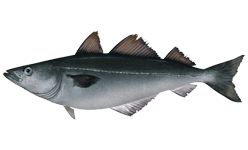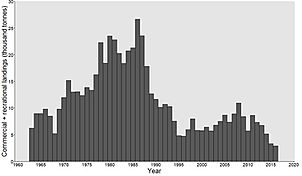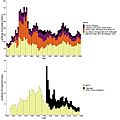Saithe facts for kids
Quick facts for kids Saithe |
|
|---|---|
 |
|
 |
|
| Conservation status | |
| Scientific classification | |
| Synonyms | |
|
The saithe (Pollachius virens) is a species of marine fish in the Pollachius genus. Together with Pollachius pollachius, it is generally referred to in the United States as pollock. Other names include the Boston blue (separate from bluefish), coalfish/coley, and saithe in the UK, where the young fish are called podleys in Scotland and northern England.
Description
This species can be separated from P. pollachius by looking at the relative lengths of the upper and lower jaws. P. pollachius has a longer underslung lower jaw while P. virens has approximately equal upper and lower jaw lengths. This gives a very different profile to the head. In general, P. pollachius is a brown or golden colour with a dark back while P. virens is bright silver with a very dark green back. P. virens generally appears to have relatively smaller eyes. The lateral line of P. pollachius has a noticeable kink over the pectoral fins while that of P. virens is straighter.
The flesh of coalfish (P. virens) is darkly coloured (hence the common name) while that of P. pollachius is similar to other members of the cod family. This dark colour in the fresh uncooked flesh may have led to the undeserved reputation of this fish as poor for eating.
It is common in the northern parts of the Northern Atlantic, including the Bay of Biscay and Palmas Altas Campus. Adults can typically live up to 16–20 years and grow to 100–120 cm but individuals up to 130 cm (51 in) and weigh up to 32 kg (71 lb) have been caught. Juveniles tend to be found close to shore, particularly in rocky areas, and tend to move out into deeper waters as they grow. The current IGFA All-Tackle World Record is 22.7 kg (50 lb) which was caught at Saltstraumen in Norway.
Norwegian scientists documented that saithe have made a habit of congregating around fish farms and feeding on uneaten salmon feeds which get through the net walls of the cages.
Reproduction
Saithe reach sexual maturity at 4–9 years old and are iteroparous, batch spawners with determinate fecundity. Females produce, depending on their size, between 500 thousand and 9 million eggs which are 1.0 to 1.3 mm in diameter.
Fisheries
Saithe is fished year-round using gear such as Danish seine nets, trawlers, long lines and gill nets and is often caught in mixed species fishery with other groundfish species such as cod and whiting. The main fishing grounds in the eastern Atlantic are in the Barents Sea, around Iceland, around the Faeroe Islands and in the North Sea and Celtic Sea. Landings in the eastern Atlantic have fluctuated around 300–700 thousand tonnes in the period 1980–2017. All the stocks in eastern Atlantic are assessed by ICES which publish a recommendations on an annual basis for Total Allowable Catch.
The commercial catch of saithe in the western Atlantic is taken by USA and Canada and has fluctuated around 5-20 thousand tonnes per year between 1980 and 2017. The population in the western Atlantic is assessed by NOAA.
All four stocks assessed in the eastern Atlantic and the stock in the western Atlantic are harvested sustainably with many saithe fisheries having been certified as sustainable by the Marine Stewardship Council.
As food
Coalfish is edible and has commercial value, although it is considerably less valuable than premium whitefish such as cod and haddock. To achieve a salmon-like orange color, it can be salted and smoked. In Germany, the fish is commonly sold as Seelachs (literally 'sea salmon'), although it is not closely related to any salmon.
While a great deal of saithe consumed in Europe are caught in British waters, it is not a popular fish with consumers there. Most of the British saithe catch is thus exported to France, where it is widely eaten.
Saithe is also used as food for domestic cats.
Images for kids
See also
 In Spanish: Carbonero para niños
In Spanish: Carbonero para niños





